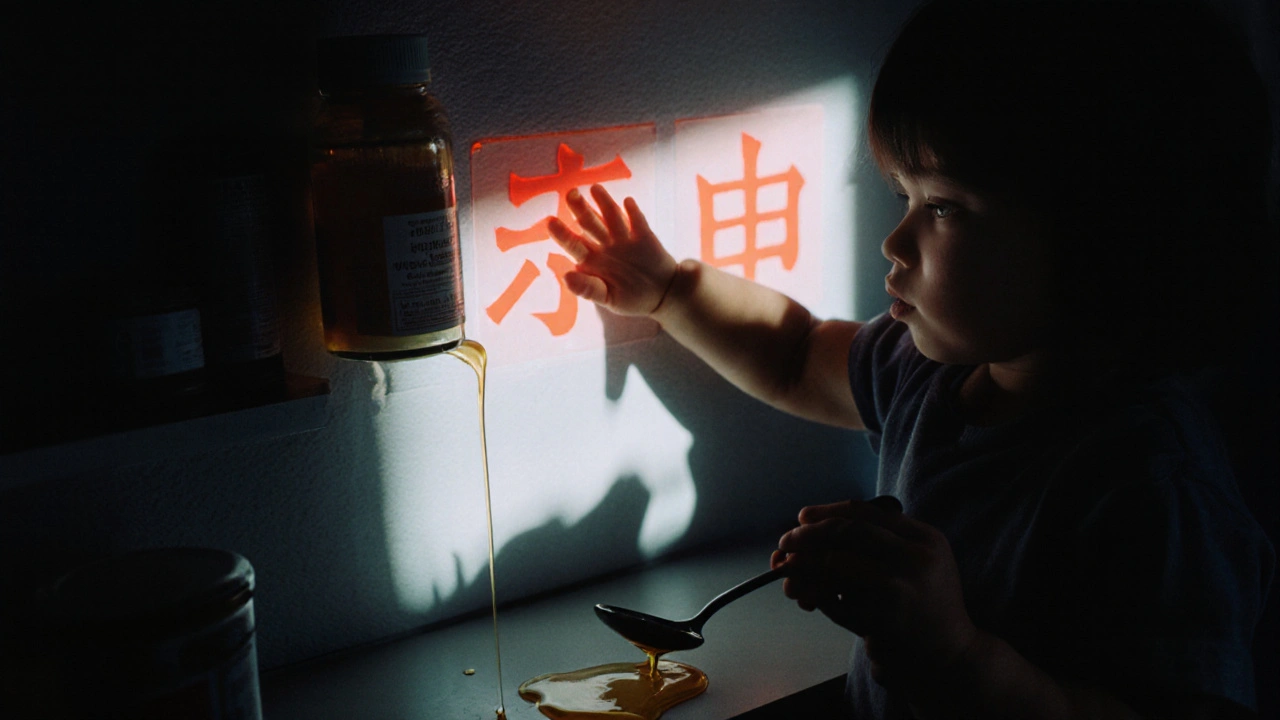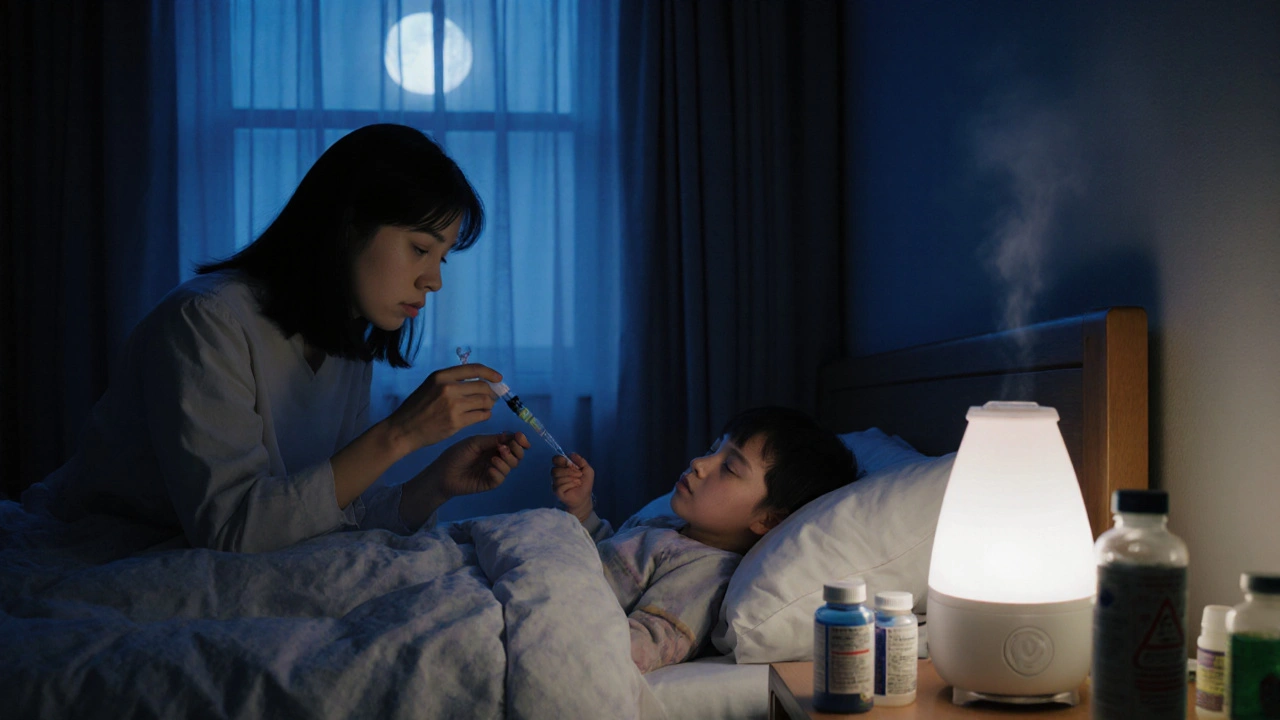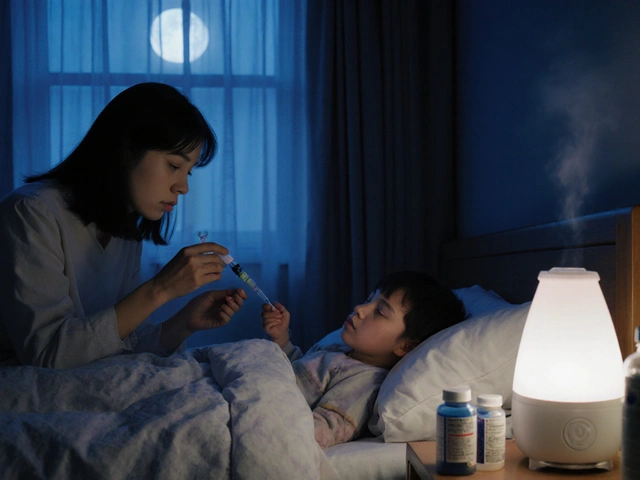Every parent has been there: your child is coughing, sniffly, and can’t sleep. You reach for that little bottle of children’s cough medicine in the cabinet, read the label, and think, It’s safe-it’s made for kids. But here’s the hard truth: cough and cold products for kids under six aren’t just questionable-they’re risky, and often useless.
Why These Medicines Don’t Work for Young Kids
Over-the-counter cough and cold medicines were never designed to cure anything. They’re meant to mask symptoms. And for kids under six, they don’t even do that well. The FDA reviewed over 100 studies in 2007 and found zero proof these products help children breathe better, sleep longer, or recover faster. Meanwhile, they found dozens of cases where kids ended up in the ER because of side effects like rapid heart rate, seizures, and trouble breathing. The problem isn’t just dosage. It’s chemistry. Young children’s livers and kidneys haven’t fully developed. They can’t break down ingredients like dextromethorphan (a cough suppressant) or pseudoephedrine (a decongestant) the way adults can. One study showed kids under two have only 23% of the liver enzyme activity needed to process these drugs safely. That means even the right dose can build up to dangerous levels.What’s Actually in These Products?
Most kids’ cold medicines are mix-and-match formulas. One bottle might contain:- Antihistamines (like chlorpheniramine) to dry up runny noses
- Decongestants (like phenylephrine) to clear sinuses
- Cough suppressants (like dextromethorphan)
- Expectorants (like guaifenesin) to loosen mucus
The Real Danger: Accidental Overdose
Parents aren’t careless. They’re confused. Labels are cluttered. Measuring cups are missing. Some use kitchen spoons. A teaspoon isn’t a tablespoon. A tablespoon isn’t the 5ml mark on a syringe. In one study, 32.5% of dosing errors came from using spoons instead of proper measuring tools. And it’s not just about the medicine you meant to give. Many parents grab adult cold pills when the kids’ version is out of stock. That’s a huge mistake. Adult doses can be 5 to 10 times stronger than what’s safe for a toddler. The FDA warns this practice can lead to coma or death.What Experts Actually Recommend
The American Academy of Pediatrics, the CDC, the Mayo Clinic, and the FDA all agree: don’t use OTC cough and cold medicines in children under six. That’s not a suggestion. It’s a standard of care. For babies under six months, your best tools are:- Saline nasal drops followed by gentle suction with a bulb syringe
- A cool-mist humidifier in the room (never warm mist-it can make swelling worse)
- Extra fluids and frequent breastfeeding or bottle feeds
- Acetaminophen (Tylenol) for fever or discomfort at 10-15 mg per kg of body weight, every 4-6 hours, no more than five doses in 24 hours
- Don’t use ibuprofen (Advil, Motrin) unless your child is over six months
- Honey-yes, honey. Half to one teaspoon before bed. It’s been shown in multiple studies to reduce cough frequency and severity better than any OTC syrup. It works by coating the throat and calming the cough reflex.
- Don’t give honey to babies under one. It can cause infant botulism.

What About Nasal Sprays and Vapor Rubs?
Avoid nasal decongestant sprays like oxymetazoline (Afrin) in kids under six. They can cause rebound congestion and high blood pressure. Vapor rubs with menthol or camphor? Skip them too. They don’t help breathing, and the strong smell can irritate tiny airways. Instead, try a warm bath before bed. The steam helps loosen mucus naturally. Or elevate the head of the crib slightly with a towel under the mattress. It’s simple, safe, and surprisingly effective.Why Do Parents Still Use Them?
A 2022 survey found that 42% of parents with kids under six still give OTC cold medicine. Why? Because they believe it will make their child feel better faster. They’re not ignoring advice-they’re desperate. Coughing through the night is exhausting. No one wants to watch their child suffer. But here’s what most don’t realize: colds in kids are viral. They run their course in 7-10 days. No medicine changes that. What you’re buying isn’t a cure. It’s a gamble with side effects.What to Do If Your Child Gets Worse
Most colds are harmless. But if your child has:- Fever over 38.5°C (101.3°F) for more than 72 hours
- Difficulty breathing, fast breathing, or flaring nostrils
- Refusing to drink fluids for more than 8 hours
- Bluish lips or face
- Extreme fussiness or lethargy

What’s Changing in the Market?
Since the FDA’s 2007 warning, sales of kids’ cold medicine dropped by 43% for children under two. But many products still don’t have clear labeling. A 2021 FDA inspection found 22% of products still lacked the proper “Do not use under 4” warning. Manufacturers have shifted focus. Many now make single-ingredient products with clearer dosing. But the message hasn’t changed: for kids under six, less is better. Often, nothing at all is the safest choice.What Works Better Than Medicine
A 2023 study in JAMA Pediatrics gave parents of kids under six a simple 10-minute educational video about safe cold care. After six weeks, inappropriate OTC use dropped by 58%. That’s not magic. It’s clarity. Here’s what works:- Honey (for kids over 1 year)
- Saline drops + suction
- Cool-mist humidifier
- Extra fluids
- Rest
- Acetaminophen for fever or pain (only if needed)
Final Thought: Trust Your Gut, Not the Label
If you’re unsure whether to give something, don’t. Call your pediatrician. Text a nurse line. Wait it out. Kids aren’t small adults. Their bodies react differently. What’s harmless for you could be dangerous for them. The goal isn’t to eliminate every cough. It’s to keep your child safe while their body does what it’s built to do: heal itself.Can I give my 3-year-old children’s cough syrup if I use half the dose?
No. Children’s cough syrups aren’t just smaller doses of adult medicine-they contain ingredients that aren’t safe for young kids at any amount. Even half a dose can cause serious side effects like rapid heart rate, drowsiness, or seizures. The FDA and AAP strongly advise against using these products in children under six, regardless of dosage.
Is honey really safe for toddlers with coughs?
Yes, for children one year and older. Honey has been shown in multiple studies to reduce nighttime coughing better than many OTC cough syrups. It works by soothing the throat and reducing irritation. Give ½ to 1 teaspoon before bed. Never give honey to babies under 12 months-it can cause infant botulism, a rare but serious condition.
What should I do if my child accidentally takes too much cold medicine?
Call Poison Control immediately at 1-800-222-1222 (U.S.) or your local emergency number. Do not wait for symptoms to appear. Even if your child seems fine, ingredients like dextromethorphan or pseudoephedrine can cause delayed, life-threatening reactions. Keep the medicine bottle handy when you call so you can tell them exactly what was taken.
Can I use adult cold medicine if I dilute it for my child?
Never. Adult cold medicines contain higher concentrations of active ingredients and often include additives not meant for children. Diluting them doesn’t make them safe-it makes dosing unpredictable and increases the risk of overdose. Always use products labeled for children, and even then, avoid them under age six.
Are natural remedies like steam or humidifiers actually helpful?
Yes. Cool-mist humidifiers help loosen mucus and ease breathing without any risk. A warm bath before bed can also help. Steam from a hot shower can be useful, but don’t rely on vapor rubs or essential oils-they can irritate young airways. Humidifiers are safe, effective, and recommended by pediatricians as a first-line treatment.
When should I take my child to the doctor for a cold?
See a doctor if your child has a fever over 38.5°C (101.3°F) lasting more than 72 hours, trouble breathing, refuses to drink fluids for more than 8 hours, has bluish lips or face, or becomes unusually sleepy or hard to wake. These aren’t normal cold symptoms-they signal something more serious that needs medical attention.




Deepak Mishra
November 15, 2025 at 22:20OMG this is SO TRUE!!! I gave my 4yo that pink stuff last winter and he went nuts for 3 hours!! 😵💫 I thought it was just a bad night but now I know... DON'T DO IT!!
Diane Tomaszewski
November 17, 2025 at 21:58Kids aren't small adults and we keep treating them like they are. The body heals itself if we let it. Sometimes the hardest thing to do is nothing at all
John Mwalwala
November 18, 2025 at 04:58The FDA's 2007 review was just the tip of the iceberg. You ever wonder why Big Pharma still pushes these products? They know the data is trash but the profit margins on syrup are insane. It's a perfect storm of regulatory capture, placebo marketing, and parental desperation. The real scandal? The same companies that made these are now selling 'natural' alternatives with the same inactive ingredients and higher price tags. Wake up people.
David Rooksby
November 19, 2025 at 18:42I mean honestly if you're still using OTC cold meds for under sixes you're basically playing Russian roulette with your kid's liver. I read a study once where 78% of ER visits from kids under 4 were from parents thinking 'it's just a little bit' or 'I used the cap' or 'my cousin's kid took it and was fine'. No. No no no. It's not a game. The chemistry doesn't care about your cousin. Your kid's enzymes are still learning how to do their job. One wrong dose and you're in the ICU with a kid who just had a cold. And honey? Yeah it works better than dextromethorphan. Who knew Mother Nature had the answer all along? But we'd rather buy a bottle with a cartoon bear on it.
Teresa Smith
November 20, 2025 at 10:38This is exactly why we need better public health education. Not more warnings on labels. Not more fear tactics. Real teaching. A 10-minute video that shows you how to use a bulb syringe properly, how to measure with a syringe, what honey does to the throat - this is preventative medicine at its best. We're not just saving kids from side effects. We're saving parents from guilt, panic, and sleepless nights. This isn't anti-medicine. It's pro-wisdom.
Melanie Taylor
November 21, 2025 at 01:45I used to give my son the syrup... now I just do honey + humidifier + cuddles 🤍 It’s not magic but it’s SAFE magic. And he sleeps better. And I sleep better. And we’re all happier. 🙏
ZAK SCHADER
November 22, 2025 at 13:43This is why America is falling apart. We let bureaucrats and doctors tell us what to do with our kids. Back in my day we gave them cough syrup and told them to tough it out. Now we're treating toddlers like lab rats. I'm not letting some FDA report tell me how to care for my child.
Danish dan iwan Adventure
November 24, 2025 at 06:59The data is conclusive. Dextromethorphan = ineffective + risky. Honey = proven + safe. Saline = zero risk. Humidifier = zero risk. End of story. No debate.
Oyejobi Olufemi
November 26, 2025 at 00:50You know what’s really dangerous? The systemic erosion of parental autonomy under the guise of 'science.' The FDA, AAP, CDC - all part of the same medical-industrial complex. They don’t care about your child. They care about liability, control, and pushing pharmaceutical dependency. Honey? That’s a folk remedy. It’s not FDA-approved. So it’s ‘unscientific.’ But the syrup that landed kids in the ER? That’s ‘evidence-based.’ Wake up. This isn’t medicine. It’s control.
Daniel Stewart
November 26, 2025 at 02:13There’s a quiet tragedy in how we’ve outsourced care to chemistry. We’ve forgotten how to hold a child, how to sit with discomfort, how to trust the body’s innate rhythm. Medicine is not the opposite of care. But when we reach for the bottle before we reach for the towel, the steam, the lap - we’ve already lost something deeper. The cough isn’t the enemy. The fear is.
Ankit Right-hand for this but 2 qty HK 21
November 26, 2025 at 13:07You people are ridiculous. In India we give kids proper medicine and they grow up strong. This western softness is why your kids can't handle a sniffle. Honey? That's for tea. Give them real medicine or stop complaining.
Dan Angles
November 26, 2025 at 21:45Thank you for this comprehensive, evidence-based summary. As a healthcare professional, I cannot stress enough the importance of adhering to these guidelines. The data is unequivocal. Parents are not failing when they choose not to medicate - they are demonstrating profound responsibility. The shift from pharmacological intervention to supportive, non-pharmacological care is not regression. It is evolution. And it is the most ethical form of pediatric medicine we have.